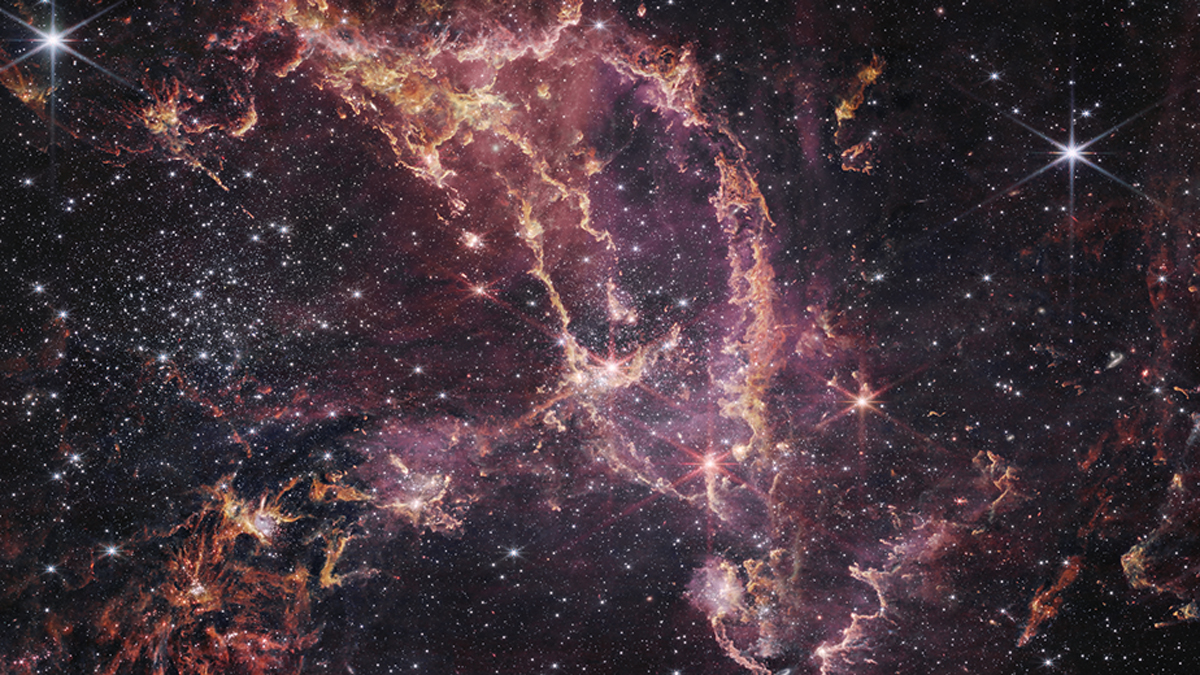'Dragon cloud' holds clues about how the biggest stars in the galaxy are born
Score one for the core accretion theory.

A massive, cold clump of material in the heart of the "Dragon cloud" is ready to form a single giant star, and astronomers got a rare glimpse of the event.
The discovery provides a window into the mysterious process of how the most massive stars in the galaxy are born.
Giant stars naturally play outsize roles in a galaxy. They consume a lot of material at their births, preventing smaller stars from forming nearby. They generate tremendous outflows over their (relatively short) lives, spewing material back into the interstellar environment. And when they die, they explode as spectacular supernovas, releasing heavy elements into the galactic mix for other stars to scoop up.
Related: How do stars die?
Despite giant stars' central role in the daily lives of galaxies, astronomers aren't exactly sure how these massive objects are born. Stars in general form from the collapse of massive clouds of gas and dust, but it's a little tricky to form a giant star. That's because in order to collapse to form a star, a cloud of gas has to release heat. But as it collapses and compresses, it heats right back up.
This back-and-forth generally makes a gas cloud fragment into many smaller clouds before stars can begin forming, which leads to the development of several small stars instead of one single large star.
One possible explanation, called the core collapse theory, states that massive stars form from a lucky coincidence. In this scenario, a massive cloud of gas compresses very quickly into a single giant lump that eventually ignites fusion and becomes a star. For this to work, the gas cloud has to collapse before it heats up and fragments, piling up all of a giant star's mass in one shot.
Get the Space.com Newsletter
Breaking space news, the latest updates on rocket launches, skywatching events and more!
A competing idea, known as the core accretion theory, offers another perspective. In this model, giant stars start out small but then suck up material from their surroundings. The key here is for the giant star to pull enough material away from the cloud, depriving any nearby stars of their own gas quickly enough before it becomes a star. Once the giant star ignites, it heats up its surroundings, pushing the gas away and preventing new flows from enlarging it.
The heart of the dragon
Astronomers have had a hard time finding evidence to favor one model over the other. One reason is that giant stars are relatively rare, so we don't have a lot to work with. The second problem is that, no matter what, giant-star formation is a pretty brisk process, so catching a forming star in the act is difficult.
It all comes down to luck, and that's exactly how a team of astronomers was able to capture just such a scenario. They announced their results in a paper accepted for publication in the journal Astronomy & Astrophysics. The astronomers used the Atacama Large Millimeter/submillimeter Array (ALMA) in Chile to make a detailed map of the "Dragon cloud," a region of active star formation about 20,000 light-years away from us.
The Dragon cloud is what's known as a massive infrared dark cloud. It's dark because it's dense enough to block significant amounts of light, and it stands out as a silhouette against the infrared light of the surrounding hotter dust. And these infrared dark clouds truly are massive: The Dragon cloud alone has enough material to manufacture over 70,000 suns.
Within the Dragon cloud, the astronomers observed several sites of ongoing star formation, but what caught their attention was a cold core sitting at the end of a long chain of newly forming stars in the center of the complex. Their detailed observations revealed that it was not one core, but two. One core weighed about twice as much as the sun, while the other was over 23 solar masses.
Most interestingly, these cores were quiet. They appeared as solitary lumps, disconnected from their environments. And the astronomers could not detect any signs of fragmentation within the cores.
This is a slam-dunk case of core accretion in action. Staring the astronomers in the face was a massive lump of ready-to-go stellar material that had not yet formed a star. In less than a million years, that core will ignite to become a giant star.
One observation is not enough to establish a trend, but it does lend credence to the core accretion model. The astronomers urged further investigation, especially with the James Webb Space Telescope, to continue monitoring the Dragon cloud and to use it as a laboratory for gaining a better understanding of how the most massive stars in the galaxy begin their lives.
Follow us @Spacedotcom, Facebook and Instagram.
Join our Space Forums to keep talking space on the latest missions, night sky and more! And if you have a news tip, correction or comment, let us know at: community@space.com.

Paul M. Sutter is an astrophysicist at SUNY Stony Brook and the Flatiron Institute in New York City. Paul received his PhD in Physics from the University of Illinois at Urbana-Champaign in 2011, and spent three years at the Paris Institute of Astrophysics, followed by a research fellowship in Trieste, Italy, His research focuses on many diverse topics, from the emptiest regions of the universe to the earliest moments of the Big Bang to the hunt for the first stars. As an "Agent to the Stars," Paul has passionately engaged the public in science outreach for several years. He is the host of the popular "Ask a Spaceman!" podcast, author of "Your Place in the Universe" and "How to Die in Space" and he frequently appears on TV — including on The Weather Channel, for which he serves as Official Space Specialist.









